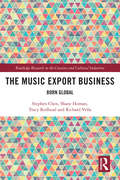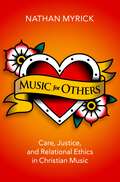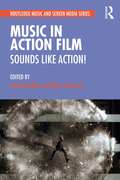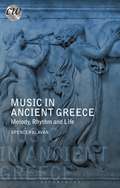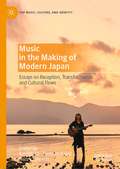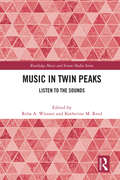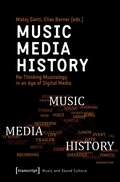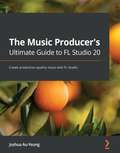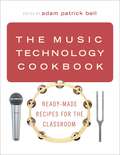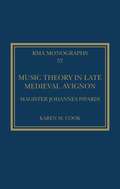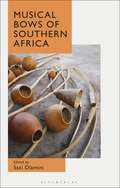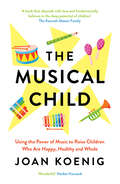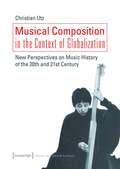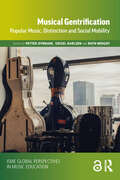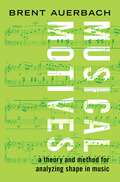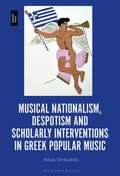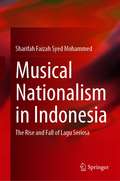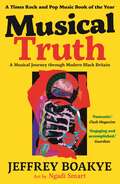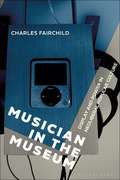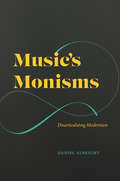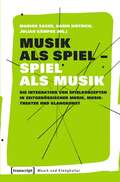- Table View
- List View
The Music Export Business: Born Global (Routledge Research in the Creative and Cultural Industries)
by Stephen Chen Shane Homan Tracy Redhead Richard VellaThe Music Export Business examines the workings of the fast-changing world of music industry exports. The music industry is in a state of flux, resulting from changes in technology, markets, government policies and most recently the COVID-19 pandemic. In analysing the ability of organisations to access international markets from inception, this book assesses global trends in music industry business models, including streaming and national export policies. The book deploys author interviews with industry insiders including musicians, managers, record labels and government stakeholders, using case studies to highlight cultural and economic value creation in a global value chain Providing research-based insights into "export readiness" in the global music industry, this book reassesses the "born global" phenomenon, providing a unique and valuable resource for scholars and reflective practitioners interested in the evolving relationship between music industries, national economies, government policies and cultural identity. .
Music for Others: Care, Justice, and Relational Ethics in Christian Music
by Nathan MyrickMusical activity is one of the most ubiquitous and highly valued forms of social interaction in North America (to say nothing of world over), being engaged from sporting events to political rallies, concerts to churches. Moreover, music's use as an affective agent for political and religious programs suggests that it has ethical significance. Indeed, many have said as much. It is surprising then that music's ethical significance remains one of the most undertheorized aspects of both moral philosophy and music scholarship. Music for Others: Care, Justice, and Relational Ethics in Christian Music fills part of this scholarly gap by focusing on the religious aspects of musical activity, particularly on the practices of Christian communities. Based on ethnomusicological fieldwork at three Protestant churches and a group of seminary students studying in an immersion course at South by Southwest (SXSW), and synthesizing theories of discourse, formation, and care ethics oriented towards restorative justice, it first argues that relationships are ontological for both human beings and musical activity. It further argues that musical meaning and emotion converge in human bodies such that music participates in personal and communal identity construction in affective ways-yet these constructions are not always just. Thus, considering these aspects of music's ways of being in the world, Music for Others finally argues that music is ethical when it preserves people in and restores people to just relationships with each other, and thereby with God.
Music in Action Film: Sounds Like Action!
by James Buhler Mark DurrandMusic in Action Film is the first volume to address the central role of music and sound in action film—arguably the most dominant form of commercial cinema today. Bringing together 15 essays by established and emerging scholars, the book encompasses both Hollywood blockbusters and international films, from classic works such as The Seven Samurai to contemporary superhero franchises. The contributors consider action both as genre and as a mode of cinematic expression, in chapters on evolving musical conventions; politics, representation, and identity; musical affect and agency; the functional role of music and sound design in action film; and production technologies. Breaking new critical ground yet highly accessible, this book will be of interest to students and scholars of music and film studies.
Music in Action Film: Sounds Like Action!
by James Buhler Mark DurrandMusic in Action Film is the first volume to address the central role of music and sound in action film—arguably the most dominant form of commercial cinema today. Bringing together 15 essays by established and emerging scholars, the book encompasses both Hollywood blockbusters and international films, from classic works such as The Seven Samurai to contemporary superhero franchises. The contributors consider action both as genre and as a mode of cinematic expression, in chapters on evolving musical conventions; politics, representation, and identity; musical affect and agency; the functional role of music and sound design in action film; and production technologies. Breaking new critical ground yet highly accessible, this book will be of interest to students and scholars of music and film studies.
Music in Ancient Greece: Melody, Rhythm and Life (Classical World)
by Spencer KlavanLife in ancient Greece was musical life. Soloists competed onstage for popular accolades, becoming centrepieces for cultural conversation and even leading Plato to recommend that certain forms of music be banned from his ideal society. And the music didn't stop when the audience left the theatre: melody and rhythm were woven into the whole fabric of daily existence for the Greeks. Vocal and instrumental songs were part of religious rituals, dramatic performances, dinner parties, and even military campaigns. Like Detroit in the 1960s or Vienna in the 18th century, Athens in the 400s BC was the hotspot where celebrated artists collaborated and diverse strands of musical tradition converged. The conversations and innovations that unfolded there would lay the groundwork for musical theory and practice in Greece and Rome for centuries to come. In this perfectly pitched introduction, Spencer Klavan explores Greek music's origins, forms, and place in society. In recent years, state-of-the-art research and digital technology have enabled us to decipher and understand Greek music with unprecedented precision. Yet many readers today cannot access the resources that would enable them to grapple with this richly rewarding subject. Arcane technical details and obscure jargon veil the subject - it is rarely known, for instance, that authentic melodies still survive from antiquity, helping us to imagine the vivid soundscapes of the Classical and Hellenistic eras. Music in Ancient Greece distills the latest discoveries into vivid prose so readers can come to grips with the basics as never before. With the tools in this book, beginners and specialists alike will learn to hear the ancient world afresh and come away with a new, musical perspective on their favourite classical texts.
Music in the Making of Modern Japan: Essays on Reception, Transformation and Cultural Flows (Pop Music, Culture and Identity)
by Kei Hibino Barnaby Ralph Henry JohnsonThis volume explores the notion of “affective media” within and across different arts in Japan, with a primary focus on music, whether as standalone product or connected to other genres such as theatre and photography. The volume explores the Japanese reception of this “affective media”, its transformation and subsequent cultural flow. Moving from a discussion of early encounters with the West through Jesuits and others, the contributors primarily consider the role of music in the nineteenth, twentieth, and twenty-first centuries. With ten original chapters, the volume covers a wealth of themes, from education, koto music, guitar making, avant-garde recorder works, musicals and rock photography, to interviews with contemporary performers in jazz, modern rock and J-pop. Innovative and fascinating, the book provides rich new insights and material to all those interested in Japanese musical culture.
Music in Twin Peaks: Listen to the Sounds
by Reba Wissner Katherine ReedIn this edited volume, contributors explore an essential element of the influential television series Twin Peaks: the role of music and sound. From its debut in 1990 to its return to television in 2017, Twin Peaks has amassed a cult following, and inspired myriad scholarly studies. This collection considers how the music and sound design not only create the ambience of this ground-breaking series, but function in the narrative, encouraging multiple interpretations. With chapters that consider how music shapes the relationship of audiences and fans to the story, the importance of sound design, and the symbolism embedded in the score, this book provides a range of perspectives for scholars of music and film studies, while giving fans new insight into an iconic television show.
Music in Twin Peaks: Listen to the Sounds
by Katherine M. ReedIn this edited volume, contributors explore an essential element of the influential television series Twin Peaks: the role of music and sound. From its debut in 1990 to its return to television in 2017, Twin Peaks has amassed a cult following, and inspired myriad scholarly studies. This collection considers how the music and sound design not only create the ambience of this ground-breaking series, but function in the narrative, encouraging multiple interpretations. With chapters that consider how music shapes the relationship of audiences and fans to the story, the importance of sound design, and the symbolism embedded in the score, this book provides a range of perspectives for scholars of music and film studies, while giving fans new insight into an iconic television show.
Music - Media - History: Re-Thinking Musicology in an Age of Digital Media (Musik und Klangkultur #44)
by Matej Santi Elias BernerMusic and sound shape the emotional content of audio-visual media and carry different meanings. This volume considers audio-visual material as a primary source for historiography. By analyzing how the same sounds are used in different media contexts at different times, the contributors intend to challenge the linear perspective of (music) history based on canonic authority. The book discusses AV-Documents (analysis in context), methodological questions (implications for research, education, and popularization of knowledge), archives of cultural memory (from the perspective of Cultural Studies) as well as digitalization and its consequences (organization of knowledge).
The Music Producer's Ultimate Guide to FL Studio 20: Create production-quality music with FL Studio
by Joshua Au-YeungLeverage the power of FL Studio 20 to create and compose production-quality songs and develop professional music production skillKey FeaturesLeverage the power of FL Studio to create your own production-level musicDevelop widely applicable music production skills and learn how to promote your musicUtilize cutting-edge tools to fuel your creative ideas and publish your songsBook DescriptionFL Studio is a cutting-edge software music production environment. It's an extremely powerful and easy to use tool for creating music. This book will give you everything you need to produce music with FL Studio at a professional level. You'll begin by exploring FL studio 20's vast array of tools and discover best practices, tips, and tricks for creating music. You'll learn how to set up your studio environment, create a beat, compose a melody and chord progression, mix sounds with effects, and export songs. You'll learn how to use tools such as the Piano roll, mixer console, audio envelopes, types of compression, equalizers, vocoders, vocal chops, and tools for increasing stereo width. The book introduces you to mixing best practices and how to master your songs. Along the way, you'll explore glitch effects and create your own instruments and custom designed effect chains. We'll also cover ZGameEditor Visualizer, a tool for creating reactive visuals for your songs. Finally, you'll learn how to register, sell, and promote your music. By the end of this FL Studio book, you'll be able to utilize cutting-edge tools to fuel your creative ideas, mix music effectively, and publish your songs.What you will learnGet up and running with FL Studio 20Record live instruments and vocals and process themCompose melodies and chord progressions on the Piano rollDiscover mixing techniques and apply effects to your tracksExplore best practices to produce music like a professionalPublish songs in online stores and promote your music effectivelyWho this book is forThis book is for music producers, composers, songwriters, DJs, and audio engineers interested in creating their own music, improving music production skills, mixing and mastering music, and selling songs online. To get started with this book, all you need is a computer and FL Studio.
MUSIC TECHNOLOGY COOKBOOK C: Ready-Made Recipes for the Classroom
by Adam Patrick BellFeaturing 56 lessons by 49 music technology experts from around the world, The Music Technology Cookbook is an all-in-one guide to the world of music technology, covering topics like: composition (with digital audio workstations such as Ableton, Soundtrap, GarageBand); production skills such as recording, editing, and equalization; creating multimedia (ringtones, soundscapes, audio books, sonic brands, jingles); beatmaking; DJing; programming (Minecraft, Scratch, Sonic Pi, P5.js); and, designing instruments (MaKey MaKey). Each lesson tailored for easy use and provides a short description of the activity, keywords, materials needed, teaching context of the contributing author, time required, detailed instructions, modifications for learners, learning outcomes, assessment considerations, and recommendations for further reading. Music educators will appreciate the book's organization into five sections--Beatmaking and Performance; Composition; Multimedia and Interdisciplinary; Production; Programming--which are further organized by levels beginner, intermediate, and advanced. Written for all educational contexts from community organizations and online platforms to universities and colleges, The Music Technology Cookbook offers a recipe for success at any level.
Music Theory in Late Medieval Avignon: Magister Johannes Pipardi (Royal Musical Association Monographs)
by Karen M. CookThe manuscript Seville, Biblioteca Colombina y Capitular 5-2-25, a composite of dozens of theoretical treatises, is one of the primary witnesses to late medieval music theory. Its numerous copies of significant texts have been the focus of substantial scholarly attention to date, but the shorter, unattributed, or fragmentary works have not yet received the same scrutiny. In this monograph, Cook demonstrates that a small group of such works, linked to the otherwise unknown Magister Johannes Pipudi, is in fact much more noteworthy than previous scholarship has observed. The not one but two copies of De arte cantus are in fact one of the earliest known sources for the Libellus cantus mensurabilis, purportedly by Jean des Murs and the most widely copied music theory treatise of its day, while Regulae contrapunctus, Nota quod novem sunt species contrapunctus, and a concluding set of notes in Catalan are early witnesses to the popular Ars contrapuncti treatises also attributed to des Murs. Disclosing newly discovered biographical information, it is revealed that Pipudi is most likely one Johannes Pipardi, familiar to Cardinal Jean de Blauzac, Vicar-General of Avignon. Cook provides the first biographical assessment for him and shows that late fourteenth-century Avignon was a plausible chronological and geographical milieu for the Seville treatises, hinting provocatively at a possible route of transmission for the Libellus from Paris to Italy. The monograph concludes with new transcriptions and the first English translations of the treatises.
Music Theory in Late Medieval Avignon: Magister Johannes Pipardi (Royal Musical Association Monographs)
by Karen M. CookThe manuscript Seville, Biblioteca Colombina y Capitular 5-2-25, a composite of dozens of theoretical treatises, is one of the primary witnesses to late medieval music theory. Its numerous copies of significant texts have been the focus of substantial scholarly attention to date, but the shorter, unattributed, or fragmentary works have not yet received the same scrutiny. In this monograph, Cook demonstrates that a small group of such works, linked to the otherwise unknown Magister Johannes Pipudi, is in fact much more noteworthy than previous scholarship has observed. The not one but two copies of De arte cantus are in fact one of the earliest known sources for the Libellus cantus mensurabilis, purportedly by Jean des Murs and the most widely copied music theory treatise of its day, while Regulae contrapunctus, Nota quod novem sunt species contrapunctus, and a concluding set of notes in Catalan are early witnesses to the popular Ars contrapuncti treatises also attributed to des Murs. Disclosing newly discovered biographical information, it is revealed that Pipudi is most likely one Johannes Pipardi, familiar to Cardinal Jean de Blauzac, Vicar-General of Avignon. Cook provides the first biographical assessment for him and shows that late fourteenth-century Avignon was a plausible chronological and geographical milieu for the Seville treatises, hinting provocatively at a possible route of transmission for the Libellus from Paris to Italy. The monograph concludes with new transcriptions and the first English translations of the treatises.
Musical Bows of Southern Africa
by Sazi DlaminiMusical Bows of Southern Africa brings together current scholarly research that documents a rich regional diversity as well as cultural relationships in bow music knowledge and contemporary practices. The book is framed as a critical appraisal of traditional ethnomusicological studies of the region – complementing pioneering studies and charting contexts for a contemporary engagement with bow music as an exchangeable cultural practice. Each contribution is written by an expert in the field and collectively demonstrates the multidisciplinary potential of bow music, highlighting the several fields of knowledge that intersect with bow music including ethno-organology, applied ethnomusicology, composition, music literacy, social development, cultural economics, history, orality, performance and language.
The Musical Child: Using The Power Of Music To Raise Children Who Are Happy, Healthy, And Whole
by Joan Koenig‘Wonderful … we need music in our lives now more than ever’ HERBIE HANCOCK‘Joan Koenig is on a wonderful mission to enrich children’s lives through music’ DR GUY DEUTSCHER A pioneering music educator reveals how music can supercharge early childhood development –and how parents and caregivers can harness it’s power.
Musical Composition in the Context of Globalization: New Perspectives on Music History in the 20th and 21st Century (Musik und Klangkultur #43)
by Christian UtzSince the early transformation of European music practice and theory in the cultural centers of Asia, Latin America, and Africa around 1900, it has become necessary for music history to be conceived globally - a challenge that musicology has hardly faced yet. This book discusses the effects of cultural globalization on processes of composition and distribution of art music in the 20th and 21st century. Christian Utz provides the foundations of a global music historiography, building on new models such as transnationalism, entangled histories, and reflexive globalization. The relationship between music and broader changes in society forms the central focus and is treated as a pivotal music-historical dynamic.
Musical Gentrification: Popular Music, Distinction and Social Mobility (ISME Series in Music Education)
by Petter Dyndahl Sidsel Karlsen Ruth WrightMusical Gentrification is an exploration of the role of popular music in processes of socio-cultural inclusion and exclusion in a variety of contexts. Twelve chapters by international scholars reveal how cultural objects of relatively lower status, in this case popular musics, are made objects of acquisition by subjects or institutions of higher social status, thereby playing an important role in social elevation, mobility and distinction. The phenomenon of musical gentrification is approached from a variety of angles: theoretically, methodologically and with reference to a number of key issues in popular music, from class, gender and ethnicity to cultural consumption, activism, hegemony and musical agency. Drawing on a wide range of case studies, empirical examples and ethnographic data, this is a valuable study for scholars and researchers of Music Education, Ethnomusicology, Cultural Studies and Cultural Sociology. The Open Access version of this book, available at http://www.taylorfrancis.com, has been made available under a Creative Commons Attribution-Non Commercial-No Derivatives (CC-BY-NC-ND) 4.0 license.
Musical Gentrification: Popular Music, Distinction and Social Mobility (ISME Series in Music Education)
by Petter Dyndahl Sidsel Karlsen Ruth WrightMusical Gentrification is an exploration of the role of popular music in processes of socio-cultural inclusion and exclusion in a variety of contexts. Twelve chapters by international scholars reveal how cultural objects of relatively lower status, in this case popular musics, are made objects of acquisition by subjects or institutions of higher social status, thereby playing an important role in social elevation, mobility and distinction. The phenomenon of musical gentrification is approached from a variety of angles: theoretically, methodologically and with reference to a number of key issues in popular music, from class, gender and ethnicity to cultural consumption, activism, hegemony and musical agency. Drawing on a wide range of case studies, empirical examples and ethnographic data, this is a valuable study for scholars and researchers of Music Education, Ethnomusicology, Cultural Studies and Cultural Sociology. The Open Access version of this book, available at http://www.taylorfrancis.com, has been made available under a Creative Commons Attribution-Non Commercial-No Derivatives (CC-BY-NC-ND) 4.0 license.
Musical Motives: A Theory and Method for Analyzing Shape in Music
by Brent AuerbachAll music fans harbor in their memories vivid fragments of their favorite works. The starting guitar solo of "Satisfaction" by the Rolling Stones, the da-da-da-DUM gesture that opens Beethoven's Fifth Symphony, the lush swelling chords of a beloved movie soundtrack: hearing the briefest snippet of any of these is enough to transport listeners into the piece's sonic and emotional world. But what makes musical motives so powerful? In Musical Motives, author Brent Auerbach looks at the ways that motives the small-scale pitch and rhythm shapes that are ever-present in music unify musical compositions and shape our experiences of them. Motives serve both to communicate basic musical meaning and to tie together sound space like the motifs in visual art. They present in all genres from classical and popular to jazz and world music, making them ideally suited for analysis. Musical Motives opens with a general introduction to these fundamental building blocks, then lays out a comprehensive theory and method to account for music's structure and drama in motivic terms. Aimed at both amateur and expert audiences, the book offers a tiered approach that progresses from Basic to Complex Motivic Analysis. The methods are illustrated by small- and large-scale analyses of pieces by Mozart, Beethoven, Handel, Chaminade, Verdi, Radiohead, and many more.
Musical Nationalism, Despotism and Scholarly Interventions in Greek Popular Music
by Nikos OrdoulidisThis book discusses the relationship between Greek Orthodox ecclesiastical music and laiko (popular) song in Greece. Laiko music was long considered a lesser form of music in Greece, with rural folk music considered serious enough to carry the weight of the ideologies founded within the establishment of the contemporary Greek state. During the 1940s and 1950s, a selective exoneration of urban popular music took place, one of its most popular cases being the originating relationships between two extremely popular musical pieces: Vasilis Tsitsanis's “Synnefiasmeni Kyriaki” (Cloudy Sunday) and its descent from the hymn “Ti Ypermacho” (The Akathist Hymn). During this period the connection of these two pieces was forged in the Modern Greek conscience, led by certain key figures in the authority system of the scholarly world. Through analysis of these pieces and the surrounding contexts, Ordoulidis explores the changing role and perception of popular music in Greece.
Musical Nationalism in Indonesia: The Rise and Fall of Lagu Seriosa
by Sharifah Faizah MohammedThis book charts the growth of the Indonesian nationalistic musical genre of lagu seriosa in relation to the archipelago's history in the 1950s and 1960s, examining how folk songs were implemented as a valuable tool for promoting government propaganda. The author reveals how the genre was shaped to fit state ideologies and agendas in the Sukarno and Soeharto eras. It also reveals the very significant role played by Radio Republik Indonesia in the genre’s development and dissemination. Little research has been done to investigate how Indonesian music contributed to nation-building during Indonesia’s immediate post-colonial period. Emulating the European art song, the genre was adapted to compose songs with the purpose of promoting a strengthened collective Indonesian identity, fostered by a group of musicians who functioned as gatekeepers, monitoring and devising various mechanisms for songs to conform to the propagandistic needs of the Indonesian government at the time. The result was the development of classical style of singing and the cultivation of a patriotic collection of music during the Guided Democracy period (1959–1965), which peaked at the height of the Konfrontasi (1963–1966). Lagu seriosa lost popularity as popular music infiltrated Indonesia in the 1970s, but it remains an iconic yet understudied aspect of the nationalistic agenda in Indonesia. The case studies of selected songs reflected continuity and change in musical style and over time. This book is of interest to scholars studying the intersection between history, politics, identity, arts and cultural studies in Indonesia. It is also of interest to researchers investigating the role of music in identity formation and nation-building more widely.
Musical Truth: A Musical History of Modern Black Britain in 28 Songs
by Jeffrey BoakyeMusic can carry the stories of history like a message in a bottle.Lord Kitchener, Neneh Cherry, Smiley Culture, Stormzy . . . Groundbreaking musicians whose songs have changed the world. But how? This exhilarating playlist tracks some of the key shifts in modern British history, and explores the emotional impact of 28 songs and the artists who performed them.This book redefines British history, the Empire and postcolonialism, and will invite you to think again about the narratives and key moments in history that you have been taught up to now.Thrilling, urgent, entertaining and thought-provoking, this beautifully illustrated companion to modern black music is a revelation and a delight.
Musician in the Museum: Display and Power in Neoliberal Popular Culture
by Charles FairchildIn recent years, popular music museums have been established in high profile locations in many of the presumed “musical capitals” of the world, such as Los Angeles, Liverpool, Seattle, Memphis, and Nashville. Most of these are defined by expansive experiential infrastructures centered around spectacular, high-tech displays of varying sizes and types. Through over-the-top acts of display, these museums influence and reflect the values and priorities in the public life of popular music. This book examines the phenomenon of the popular music museum outside the typical and familiar frames of heritage and tourism. Instead, it looks at these institutions as markers of the broader entertainment industry in the era of its rise to global dominance. It highlights the multiple manifestations of power as read across a range of institutions and material forms and discusses how this contributes to shaping the experience of popular culture.
Music's Monisms: Disarticulating Modernism
by Daniel AlbrightDaniel Albright investigates musical phenomena through the lens of monism, the philosophical belief that things that appear to be two are actually one. Daniel Albright was one of the preeminent scholars of musical and literary modernism, leaving behind a rich body of work before his untimely passing. In Music’s Monisms, he shows how musical and literary phenomena alike can be fruitfully investigated through the lens of monism, a philosophical conviction that does away with the binary structures we use to make sense of reality. Albright shows that despite music’s many binaries—diatonic vs. chromatic, major vs. minor, tonal vs. atonal—there is always a larger system at work that aims to reconcile tension and resolve conflict. Albright identifies a “radical monism” in the work of modernist poets such as T. S. Eliot and musical works by Wagner, Debussy, Britten, Schoenberg, and Stravinsky. Radical monism insists on the interchangeability, even the sameness, of the basic dichotomies that govern our thinking and modes of organizing the universe. Through a series of close readings of musical and literary works, Albright advances powerful philosophical arguments that not only shed light on these specific figures but also on aesthetic experience in general. Music’s Monisms is a revelatory work by one of modernist studies’ most distinguished figures.
Musik als Spiel - Spiel als Musik: Die Integration von Spielkonzepten in zeitgenössischer Musik, Musiktheater und Klangkunst (Musik und Klangkultur #40)
by Sebastian RoseAußermusikalische Prinzipien des Spiels - freie wie streng regelbasierte - können Kompositionsprozesse, Aufführungssituationen oder Rezeptionsvorgänge prägen und bestehende Denkmuster aufbrechen. Daher hat der Spielbegriff als ästhetische Kategorie in den Künsten des 20. Jahrhunderts deutlich an Relevanz gewonnen und bis heute entstehen vielfältige kompositorische Konzepte, die Formen, Interaktionen und Oberflächen von analogen wie digitalen Spielen adaptieren. Die Beiträger*innen aus den Bereichen Komposition, Musik- und Kulturwissenschaft und Spieleentwicklung untersuchen markante Beispiele, in denen auf je eigene Weise Musik und Spiel als zwei eigenständig gewachsene Kulturformen zusammengeführt werden.
